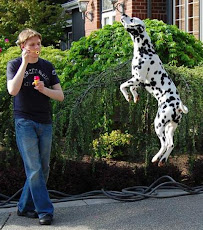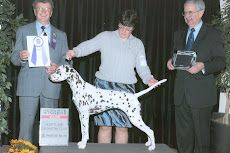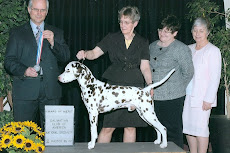If I’d been fishing yesterday, I’d have been very satisfied with my catch. Am always amazed at who reads this blog, shares what I have written, and how quickly people respond when they take issue with something. Because I use my blog to express opinions (of which I have many), entertain, practice my hobby of writing, and (hopefully) to educate, I do step on toes from time to time, but I never name names. My opinions as I have said before, are strictly my own.
Yesterday’s posting drew responses from four individuals, referring to three different dogs. Tails seem to be a touchier topic than trim. In one case if the tail was fixed it was a mighty poor job. In another case I don’t recall ever having seen the dog in the ring (but now of course I wonder about its tail).
Let me just say that I have owned and bred more than my share of dogs with high or hooky (curly) tails, and have had stud dogs that sired them on a regular basis. We’ve placed as pets some very handsome teenaged dogs with tails we’ve hated, and finished but never bred from other dogs with tails we’ve hated. When I see those dogs later their tails never improved with time. Heck, I can breed together two dogs with perfect tails and get bad ones. I even bred a dog whose owner had his tail fixed – badly. It went from a common flagpole tail, to a flagpole tail where the last 4 inches dangled limply. I can also recall several aspiring specials (not mine!) whose careers were ended by bad fix jobs. When half of the tail dangles loosely for more than a few days, it’s generally a bad fix. The first few days it might just be what’s called a “cold tail”, a tail injury that is not uncommon in Dals and other long tailed breeds, after that well, perhaps it was shut in the car door. . .
One thing I have found to be true in ALL the major lines I have worked with over the years, including Watseka, Melody, Coachman, Long Last and many generations of Paisley, is that tails do not miraculously get better on adult dogs as they mature, and they often get worse. Puppy tails may go up by 6 weeks and come down by 4 or 5 months (the trick is to guess which ones if any WILL come down) and a few others will come down before the dog is fully grown (sometimes after a bitch’s first season). Teenaged dogs may carry their tails high when excited, as will dogs of both sexes when they first walk into a dog show, but in 40 years of tail watching I have never seen a consistently high tail correct itself on a mature adult dog. The same holds true of hooks, only more so – they are even more likely to get worse.
Wrapping can bring a tail down for a while, but timing can be a problem as the tail does not stay down for very long, and in a large entry it may well be up again before judging is over. I once wrapped a dog’s high tail and got through Winners Dog for a nice big major. By the time we came back in for breed, the tail was up and the judge actually commented on the difference – but still gave us Best Of Winners. I think that was the last time we tried it and that was many many years ago.
If YOU are truly blessed with an animal whose tail did correct itself, I hope that trait is the one passed on to its offspring. I'm sure this posting will generate emails from people who will swear it happened to them. Lucky you!
At a Judges Education Seminar I attended years ago, someone asked the late Annie Clark how hard one should penalize bad tails in Poodles. She replied that she did not judge them “too harshly” as that would cause more people to get tails “fixed”, which would make it harder for the breeders to tell what they were breeding to and actually make the problem worse. Unfortunately, Dal people seem to be so used to bad tails they don’t even care.
Helen – hope that answered your question on tails. On noses I was referring to enhanced coloring, usually tattooing, but sometimes help comes from a bottle or a tube. Fixes are illegal, but most are virtually impossible to detect and a judge has to judge the dog as it appears on that day.
















































1 comment:
Hi Sue,
What kind, if any, heartworm prevention do you use? Also what kind of flea and tick prevention do you like?
Thanks, Jen
Post a Comment